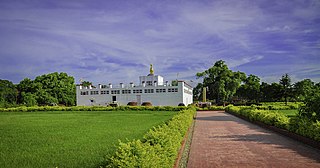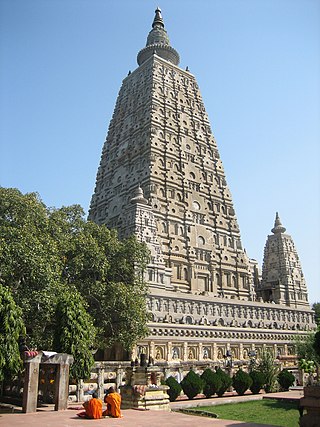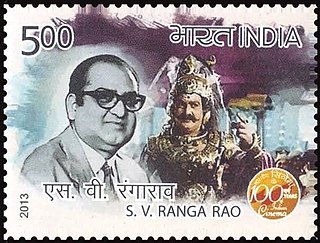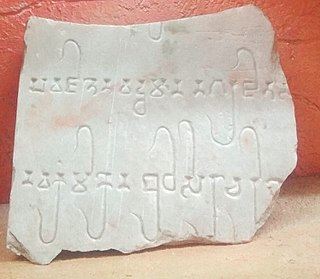
Lumbinī is a Buddhist pilgrimage site in the Rupandehi District of Lumbini Province in Nepal. It is the place where, according to Buddhist tradition, queen Maya gave birth to Siddhartha Gautama at around 623 BCE. Gautama, who, according to Buddhist tradition, achieved Enlightenment some time around 528 BCE, became Shakyamuni Buddha and founded Buddhism. Lumbini is one of many magnets for pilgrimage that sprang up in places pivotal to the life of the Buddha.

Bodh Gayā is a religious site and place of pilgrimage associated with the Mahabodhi Temple complex, situated in the Gaya district in the Indian state of Bihar. It is famous for being the place where Gautama Buddha is said to have attained enlightenment under what became known as the Bodhi Tree. Since antiquity, Bodh Gayā has remained the object of pilgrimage and veneration, for both Hindus and Buddhists. In particular, archaeological finds, including sculptures, show that the site was in use by Buddhists since the Mauryan period. Bodh Gayā and the nearby regions were invaded and destroyed in the 12th century CE by Muslim Turk armies, led by Delhi Sultanate's Qutb al-Din Aibak and Bakhtiyar Khilji.

The Mahabodhi Temple or the Mahābodhi Mahāvihāra, a UNESCO World Heritage Site, is an ancient, but restored Buddhist temple in Bodh Gaya, Bihar, India, marking the location where the Buddha is said to have attained enlightenment. Bodh Gaya is 15 km from Gaya and is about 96 km (60 mi) from Patna. The site contains a descendant of the Bodhi Tree under which the Buddha gained enlightenment, and has been a major pilgrimage destination of Buddhists for over two thousand years.

Eluru is a city and the district headquarters of Eluru district in the Indian state of Andhra Pradesh. It is one of the 14 municipal corporations in the state and the mandal headquarters of Eluru mandal in the Eluru revenue division. The city is on the Tammileru river. The city is well known for its wool-pile carpets and hand woven products. As of 2011 Census of India, the city had a population of 214,414. Its history dates back to the second century CE.

Samarla Venkata Ranga Rao, popularly known as SVR, was an Indian actor and filmmaker known for his works majorly in Telugu and Tamil films. He is regarded as one of the finest actors in the history of Indian cinema. He is known by the epithet "Viswa Nata Chakravarthi". He was the earliest known character actor to have enjoyed a star status in South Indian cinema. In a career spanning nearly three decades, Ranga Rao garnered various national and international honours.

Hinduism in South India refers to the Hindu culture of the people of South India. Hinduism in South India is characterized by Dravidian customs and traditions, hence it is also called Dravidian Hinduism. The Dravidians made great contributions to the development of Hinduism. South India was the birthplace of many Hindu saints and reformers. The Brahmins of ancient Dakshinapatha were classified as Pancha-Dravida. The Hindus in South India are followers of various Hindu branches such as Vaishnavism,Shaivism, Shaktism, Brahmanism and others. Hinduism was the state religion of most of the South Indian kingdoms. During the Ancient and Middle Ages were built in South India one of the greatest Hindu temples. South Indian kings such as the Cholas spread Hinduism overseas to parts of Southeast Asia. The activities of South India across the Palk Strait led to survival of Hinduism in Sri Lanka among the Sri Lankan Tamils. Some Hindu festivals are celebrated mostly or exclusively in South India and Sri Lanka. In South India are also numerous Hindu pilgrimage site that is visited annually by thousands of devotees.

Chaukhandi Stupa is a Buddhist stupa in Sarnath located 8 kilometres from Cantt Railway Station in Varanasi, Uttar Pradesh, India. Stupas have evolved from burial mounds and serve as a shrine for a relic of the Buddha. The site was declared to be a monument of national importance by the Archaeological Survey of India in June 2019.

Thotlakonda Buddhist Complex is situated on a hill near Bheemunipatnam about 15 kilometres (9.3 mi) from Visakhapatnam in Andhra Pradesh, India. The hill is about 128 metres (420 ft) above sea level and overlooks the sea. The Telugu name Toṭlakoṇḍa derived from the presence of a number of rock-cut cisterns hewn into the bedrock of the hillock. In 2019, the stupa was partially damaged due to monsoons, but it was restored by 2021 at the cost of Rs 42 lakh.

Kondaveedu Fort is a historically significant ancient hill fortress located in Kondaveedu, a village in the Chilakaluripet constituency of Palnadu district, Andhra Pradesh, India. The site is located 16 miles west of the city of Guntur. Apart from this main fort, there are two other forts nearby. Efforts are in progress to classify Kondaveedu Fort as a UNESCO World Heritage Site.

Durgam Cheruvu, also known as Raidurgam Cheruvu, is a freshwater lake located in Rangareddy district, Jagathgiri Gutta, Telangana, India. The lake, which is spread over 83 acres (34 ha), is located near the city of Hyderabad. The lake is also known as Secret Lake because it is hidden between the localities of Jubilee Hills and Madhapur. The Durgam Cheruvu Bridge, which traverses the lake, was inaugurated in September 2020.

Phanigiri is a Buddhist site in Suryapet district, Telangana. It dates to the 1st Century BCE - 4th century CE period.

Gunadala Matha Shrine, located in the city of Vijayawada, Andhra Pradesh, is a renowned Catholic pilgrimage site attracting approximately 10 lakh devotees during its annual festival. The site features a church, a grotto, and the stations of the Cross along the hill leading to the 18-foot-high holy cross erected at the hill's summit. It is considered the second biggest worship place of Mary, mother of Jesus after Basilica of Our Lady of Good Health at Velankanni in Tamil Nadu.

Gopalapatnam is a neighborhood in the city of Visakhapatnam, India. The neighborhood is considered to be the major residential and commercial area in the district. It is located within the jurisdiction of the Greater Visakhapatnam Municipal Corporation, which is responsible for the area's civic amenities. It is located on the western fringe of Visakhapatnam. The Visakhapatnam gas leak occurred in the neighborhood on 7 May 2020.

Eluru New bus station is a bus station located in Eluru city of the Indian state of Andhra Pradesh. It is owned by Andhra Pradesh State Road Transport Corporation. This is one of the major bus stations in the state, with services to all the cities and towns and to other states like Karnataka, Tamil Nadu and Telangana. It is one of the few stations equipped with 5G Internet service. The station is also equipped with a bus depot for storage and maintenance of buses.

There are various modes of transportation available in Eluru, a city in the Indian state of Andhra Pradesh, and its region. It includes auto rickshaws, bicycles to mass transit systems – such as buses and trains. The city was once famed for its traffic problems with the railway gates at Vatluru, Venkatraopet, Powerpet, Old bus stand and Eastern Locks areas. When the National Highway passed through the city, the traffic hurried to pass over the railway gates in the city and outskirts, which makes traffic worse.

The Dhyana Buddha is a statue of Gautama Buddha seated in a meditative posture located in Amaravathi, Andhra Pradesh, India. Completed in 2015, the statue is 125 ft (38 m) tall and is occupies a 4.5-acre site on the banks of the Krishna River. It is embellished with modern reproductions of sculptures from the Amaravati School of art which flourished in the region from 200 BC to 200 AD.
This is a list of ancient Buddhist sites, relics, traditions and places from the Indian state of Kerala. Even though Kerala does not have any major presence of Buddhists in modern times, many historians recognize a Buddhist heritage that seem to have existed until the 10th century CE along with a widespread Sramana tradition of co-existence between Buddhism, Jainism and ancient Dravidian folk religion.

NTR district is a district in coastal Andhra Region in the Indian state of Andhra Pradesh. The district headquarters is located at Vijayawada. The district is named after former Chief Minister of Andhra Pradesh N. T. Rama Rao. The district shares boundaries with Guntur, Palnadu, Krishna, Eluru, Khammam and Suryapet districts.

Eluru district is a district in coastal Andhra Region in the Indian state of Andhra Pradesh. With Eluru as its administrative headquarters, it was proposed on 26 January 2022 to become one of the resultant twenty six districts in the state once a final notification is issued by the government of Andhra Pradesh. It is formed from Eluru revenue division and Jangareddygudem revenue division from West Godavari district and Nuzvid revenue division from Krishna district.



















